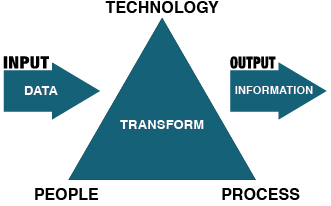1.3. Information Systems Components
Information systems are defined by the components that make up the system, and the role those components play in an organization. Information systems can be viewed as having three core components: technology, people, and process that take the data and transform it into information.

As mentioned in the previous section, technology is often what people think of when they hear the term information systems, however it is just one component. The last two components, people and processes, separate the idea of information systems from more technical fields, such as computer science. In order to fully understand information systems, you will need to understand how all of these components work together to bring value to an organization.
Book Structure
This idea forms the structure of this book.
Technology which comprises hardware, software, and networks along with an understanding of technology enabled strategy is covered in the beginning of this book in Chapters 1 through 6.
The book then focuses on how information systems are developed (Chapter 7) and what impacts and issues of information systems should be considered that involve people (Chapters 8 & 9).
Lastly, the end of the book looks at business processes and the different types of information systems that are used in business (chapters 10-13).
Technology
Technology is the application of scientific knowledge for practical purposes. From the invention of the wheel to the harnessing of electricity for artificial lighting, technology has become ubiquitous in daily life, to the degree that it is assumed to always be available for use regardless of location. Technology includes: hardware, software, and networks. Each of these will be addressed in an individual chapters in this book, but a simple introduction is provided below.
- Hardware: is the tangible, physical portion of an information system – the part you can touch. Computers, keyboards, disk drives, and flash drives are all examples of information systems hardware. How these hardware components function and work together will be covered in Chapter 3.
- Software: is the set of instructions that tell the hardware what to do. Software is not tangible – it cannot be touched. Two main categories of software are: Operating Systems and Application software. Operating Systems software provides the interface between the hardware and the Application software. Examples of operating systems for a personal computer include Microsoft Windows and Ubuntu Linux. The mobile phone operating system market is dominated by Google Android and Apple iOS. Application software allows the user to perform tasks such as creating documents, recording data in a spreadsheet, or messaging a friend. Software will be explored more thoroughly in Chapter 4.
- Networking Communication: besides the technology components (hardware & software) which have long been considered the core technology of information systems, it has been suggested that one other component should be added: communication networks. An information system can exist without the ability to communicate – the first personal computers were stand-alone machines that did not access the Internet. However, in today’s hyper-connected world, it is an extremely rare computer that does not connect to another device or to a network. Technically, the networking communication component is made up of hardware and software, but it is such a core feature of today’s information systems that it has become its own category. Networking will be covered in Chapter 6.
People
When thinking about information systems, it is easy to focus on the technology components and forget to look beyond these tools to fully understand their integration into an organization. A focus on the people involved in information systems is the next step. From the front-line user support staff, to systems analysts, to developers, all the way up to the chief information officer (CIO), the people involved with information systems are an essential element. The roles people play in information systems is explored in this chapter, but the role people play is interwoven throughout the book as it is difficult to separate people from information systems.
Process
The last component of an information system is processes. A process is a series of steps undertaken to achieve a desired outcome or goal. Information systems are becoming more integrated with organizational processes, bringing greater productivity and better control to those processes. Simply automating activities using technology is not enough – businesses looking to utilize information systems must do more. The ultimate goal is to improve processes both internally and externally, enhancing interfaces with suppliers and customers. Technology buzzwords such as ‘business process re-engineering,’ ‘business process management,’ and ‘enterprise resource planning’ all have to do with the continued improvement of these business processes and procedures and the integration of technology with them. Businesses hoping to gain a competitive advantage over their competitors are highly focused on this component of information systems. The process element in information systems will be discussed in Chapter 11.
Data
Data is the ‘power’ to the information system engine. Without it, the system simply would not be able to produce the information needed to reach the goal of improving decision making. You can think of data as a collection of facts. For example, your address (street, city state, postal code), your phone number, and your social networking account are all pieces of data. Like software, data is also intangible, unable to be seen in its native state. Pieces of unrelated data are not very useful. But aggregated, indexed, and organized together into a database, data can become a powerful tool for businesses. Organizations collect all kinds of data and use it to make decisions which can then be analyzed as to their effectiveness. The analysis of data is then used to improve the organization’s performance. Chapter 5 will focus on data and databases, and how they are used in organizations.
“Chapter 1: What Is an Information System?” from Information Systems for Business and Beyond (2019) by David Bourgeois is licensed under a Creative Commons Attribution-NonCommercial 4.0 International License, except where otherwise noted.

